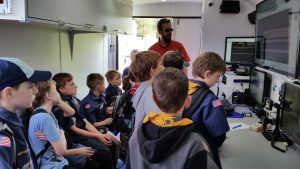ARES is an emergency communications organization. Traditionally, emcom has been concerned mostly with radio and radio-related procedures, like the mechanics of a directed net or how to professionally move NTS traffic. As we’ve marched into the 21st century, we’ve seen the ARES scope of operations expand to include many different types of technology, like radio-based email systems, APRS, logging software, and mesh networking.
One exciting technology that has been steadily improving and becoming more accessible is the use of Geographic Information Systems (GIS). GIS has moved out of the computer datacenter in the last decade, riding the coattails of smartphone adoption with “killer” GIS applications like Google Maps, Waze, and geocaching.
GIS is a broad term that can refer to a number of different technologies, processes, and methods. Of course, we’ve been making maps for thousands of years but map making is only a tiny sliver of what today’s GIS systems can do. GIS applications, like Google Maps and many others, allow users to do far more than just make maps. They are tools that can create interactive queries (user-created searches), analyze spatial information, edit data in maps, and present the results of all these operations.
It doesn’t take much imagination to see the many ways GIS could be useful in an emergency communications scenario. Maps can be an excellent way to communicate information, status, and action, and being able to quickly produce a map designed for a specific purpose (assigning teams to search grids, for example) is as critical a skill in a disaster as medical training or communications training.
GIS, like desktop publishing or website design, is both simple and hard to learn. It’s pretty easy to get the hang of the basics but it takes years of training and experience (and a degree of innate talent) to actually be good at it. Luckily for MCARES and other emergency service-type organizations, the emcom needs for GIS content are modest and don’t, generally speaking, require a GIS degree to create.
GIS has been a critical component to emergency services for decades, which is great because we don’t need to reinvent the wheel again. What we want to do is well trodden ground, in GIS terms, so let’s leverage the work others have done.
MCARES plans to facilitate basic GIS training to its members over the next 18-24 months with the goal of developing a basic GIS skill set that can be used in a variety of capabilities. MCARES will be using a training program developed for Search and Rescue by a national team of GIS and emergency service professionals. It is a self-paced program that leverages free, industry-standard software and tools.
And you don’t have to wait for MCARES to get started! Check out www.mapsar.net to review all the materials and start the training program. We hope to have a few GIS intro webinars over the summer and fall, but those will be overviews and only cover the basics. As with any skill, the value you’ll get is proportional to how much time you put into it.
Tagged as:
GIS
 Last weekend Robert WX5TEX, Steve W7SRH, John KF7ZWX, Tom KE7JTM, Adam and I operated at Fort Vancouver National Historic Site. We registered with
Last weekend Robert WX5TEX, Steve W7SRH, John KF7ZWX, Tom KE7JTM, Adam and I operated at Fort Vancouver National Historic Site. We registered with  In
In